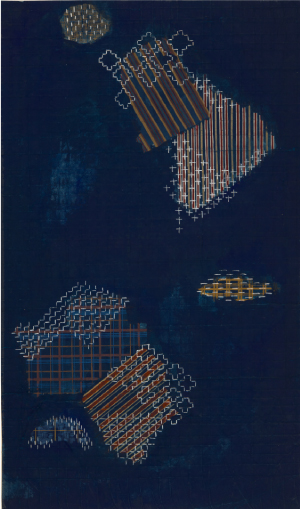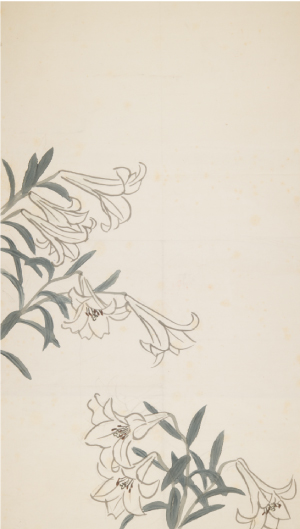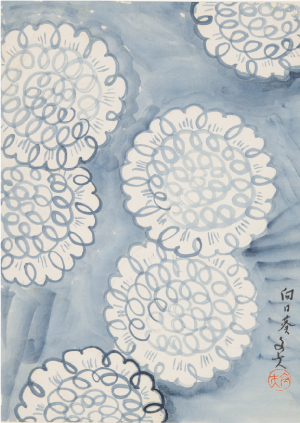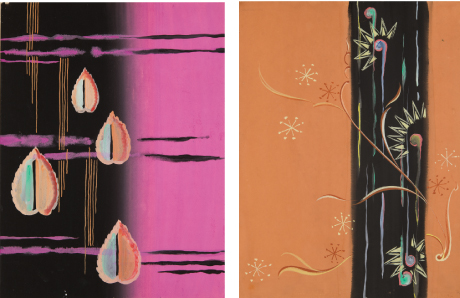
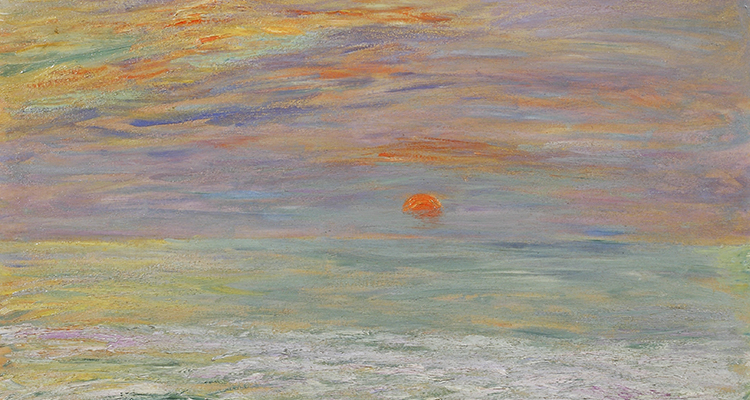
Exhibition
Marubeni Gallery Opening Exhibition IV
Textile Designs and the Akane-kai—
Spinning the Passion of the Past into the Present
Dates: May 16 - July 31, 2023
1st period : May 16 (Tues) - June 17 (Sat)
2nd period: July 3 (Mon) - July 31 (Mon)
Closed: Sundays, national holidays, and during exhibition changeover June 19 (Mon) - July 2 (Sun)
Opening hours: 10:00 - 17:00 (reception closes at 16:30)
In cooperation with Kyoto Marubeni Co., Ltd

About this Exhibition
Marubeni Gallery Opening Exhibition IV features textile design, which is one of the three pillars of the Marubeni Collection. The textile design collection is currently owned by Kyoto Marubeni Co., Ltd., but its origin dates back to the era of Marubeni Shoten, Ltd. (hereafter Marubeni Shoten), the predecessor of Marubeni Corporation, which was established through a merger of Itochu Shoten, Ltd., and Ito Chobei Shoten in 1921.
At the time, Marubeni Shoten, based in Osaka, was planning to expand into the Tokyo region, and Vice President Itoh Chuzo brought about 1000 pieces of sample fabrics for kimono to Tokyo himself to conduct market research. As a result, he became keenly aware that development of new design was crucial for doing business in Tokyo, and established a textile design study group “Akane-kai” centered around the Kyoto Branch. At the study group, about 70 artists from different fields, such as Takeuchi Seiho, Fujishima Takeji, and Asakura Fumio, were asked to present their original designs each year, which were utilized as patterns for new kimonos, obis and other textiles.
Original and unique works by designers, Japanese and Western-style painters, sculptors, lacquerware artists, and others especially selected from the collection are divided into two parts which are exhibited separately in the first and second periods of the exhibition. Several designs were commissioned to contemporary master craftsmen and made into actual kimonos and obis, so that visitors will have a chance of seeing how the designs are put to practical use.
As these designs are for making textiles, they are seldom shown to the public, therefore I hope that many people will take advantage of this occasion to appreciate the rarely seen works.
Prominent Works to be Displayed
The textile designs produced by the Akane-kai artists have a characteristic of not being standardized in their size or material. Artists who participated in Akane-kai consisted mainly of renowned artists who transcended the different fields of Japanese and Western-style painters, and designers, such as Takeuchi Seiho, Nishimura Goun, Tsuchida Bakusen (1887-1936), Fujishima Takeji (1867-1943), Ishii Hakutei, Mukai Kanzaburo (1890-1959), and Sugiura Hisui (1876-1965). In addition, the majority of artists were working in Tokyo or Kyoto, and were in a mentor-apprentice relationship or had graduated from the same art schools.
Iso-tsuzure 3 (of three pieces)
Takeuchi Seiho
1928 / Color on paper / 51.2×30.0cm / Kyoto Marubeni (2nd period)
Born in Kyoto. Japanese-style painter. Real name: Takeuchi Tsunekichi. He studied under Kono Bairei, and after studying the Shijo school was given the pseudonym ‘Seiho.’ He traveled around Europe after the 1900 Paris International Exposition where he was influenced by Turner and Corot. Upon his return to Japan he changed one kanji of ‘Seiho’ to include a character denoting ‘West.’ He skillfully incorporated Western painting expressions into Japanese sketching style and left a significant mark on the Kyoto artists’ world.
Shirayuri (White Lily)
Ishii Hakutei
1929 / Color on paper / 99.8×56.3cm / Kyoto Marubeni (2nd period)
Born in Tokyo. He first studied Japanese painting, but after studying copperplate engraving and watercolor at the Ministry of Finance Printing Bureau, switched to Western painting under the tutelage of Asai Chu. In 1914, he founded the Nika-kai with Yamashita Shintaro and Arishima Ikuma. He later parted ways with the Nika-kai and formed the Issui-kai with fellow colleagues.
Himawari (Sunflower)
Asakura Fumio
1928 / Color on paper / 46.1×33.5cm / Kyoto Marubeni (1st period)
Born in Oita Prefecture. Sculptor. Moved to Tokyo in 1902 where his elder brother and sculptor Watanabe Osao was living and entered the sculpture course at the Tokyo School of Fine Arts the following year. His consistent commitment to naturalistic realism made him an influential figure not only in the world of sculpture but also in the art world.
Modern Style
Saito Kazo
1929 / Color on paper / 37.8×28.6cm, 37.9×28.6cm / Kyoto Marubeni (1st period)
Born in Akita Prefecture. Designer. Real name: Saito Keizo. After entering the Normal School of the Tokyo Academy of Music, he transferred to the Design Department of the Tokyo School of Fine Arts. In 1913, he traveled to Germany and upon his return, established the Saito Institute of Decorative Arts. He worked progressively mainly in the fields of craft, clothing and accessories.




